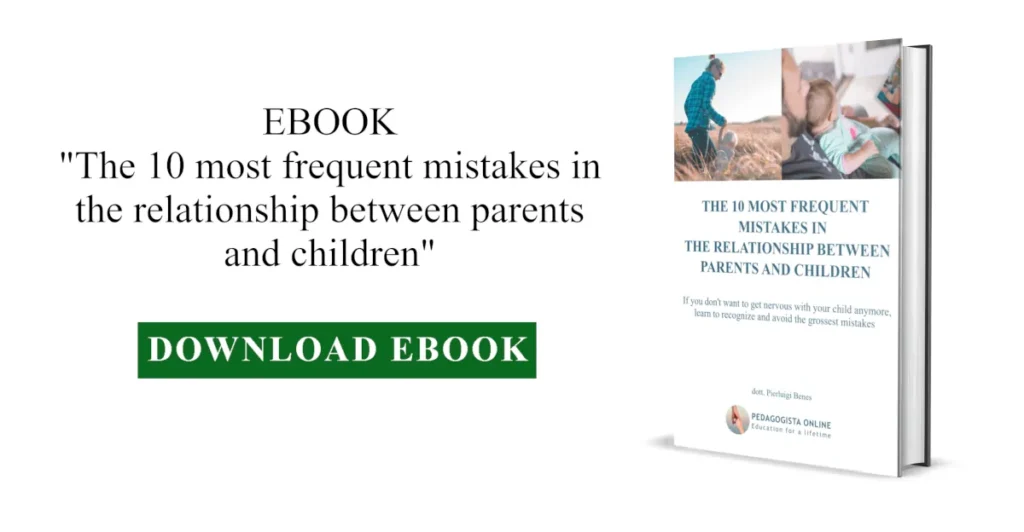Refusing to sit at the table or go to bed, insisting on playing with a friend at all costs, crying desperately in front of a justified prohibition from mom and dad — these are episodes that frequently occur in a family setting.
Sometimes they can be easily managed, while other times it’s difficult for parents to understand how to soothe a child’s tantrums. Often, we feel helpless when our children behave unreasonably and refuse to calm down. In this post, I’ll provide you with practical advice and effective methods to help you understand hot to calm a tantrum of your child; my aim is to assist you in creating a more serene family environment.
By learning to understand the underlying causes of children’s challenging behaviors and effectively managing difficult situations, you can help your children learn to manage their emotions and establish a stronger and more positive relationship with them.
So, if you want to start building an educational relationship that enables you to handle even the most complex situations in adolescence, or to support your child’s learning as best as possible, I suggest you keep reading.
1. Understanding Tantrums: The Underlying Causes of Children's Challenging Behaviors
Children’s tantrums represent a normal phase of development but can be challenging for parents to handle. It’s important to understand that tantrums are not solely a discipline issue; most of the time, they stem from a combination of other factors like tiredness, hunger, boredom, and intense emotions.
To effectively manage children’s tantrums, it’s crucial to carefully consider the underlying causes of these behaviors. For instance, a hungry child who is too young to communicate verbally can become very restless. The same happens when a child is overly tired or experiencing intense emotions, such as joy from play or fun with friends.
Even during a significant change like starting school or the arrival of a new sibling, a child can experience heightened anxiety. Younger children, moreover, do not yet possess effective emotional regulation skills, so they tend to express their discomfort, anger, or other emotions through tantrums.
For this reason, effectively managing your children’s tantrums is only possible if you first understand the child’s mood and needs at that specific moment, and then adjust your behavior accordingly.
Lastly, to help children learn to manage their emotions, certain channels can be used, such as communication, creativity (painting, writing, music…), sports, or simple relaxation techniques. This prevents tantrums and teaches the child to calm themselves during more delicate moments.
2. Preventing tantrums: how to create a serene home environment
Among the most important aspects of effectively managing children’s tantrums is prevention, which involves creating a serene home environment. Parents can take some simple measures to prevent tantrums and establish a calmer atmosphere at home.
First and foremost, it’s important to ensure that children have a stable daily routine and enough time for their essential needs such as rest, play, and meals. Remember that a child who lacks sufficient sleep or playtime can become very irritable and thus more prone to tantrums.
Secondly, creating a home environment that promotes tranquility is highly beneficial. This can involve dimming the lights a bit earlier in the evening before bedtime; it can also include setting up a quiet area where children can unwind. Additionally, playing relaxing music during transition times between activities (before meals, before bedtime, when preparing for a special event) can help.
Furthermore, consider the importance of teaching children how to manage their emotions. This can involve simple techniques like deep breathing or, in some circumstances, even practicing meditation and relaxation techniques. In my guide Fearless Parenting Method, I delve into this topic extensively, as helping children manage emotions not only makes them less susceptible to tantrums but also lays the foundation for their personal fulfillment.
Finally, it’s important for parents to be mindful of their own behaviors and strive to maintain a calm and reassuring attitude towards their children, even in stressful situations. Children often imitate their parents’ behavior, so if parents exhibit serene behaviors, children are more likely to follow suit.
3. Managing tantrums: how to react effectively in difficult situations
Children’s tantrums can be challenging to manage, but there are certain things you, as a parent, can do to effectively handle your child’s tantrums and help them calm down.
First and foremost, you need to try to remain calm during a tantrum, as getting agitated only makes it harder to control the situation. Children often escalate their emotions and frustration because parents lose control of the situation. It’s important instead to speak to the child calmly and reassuringly, explaining the reasons why a certain behavior is unacceptable, but most importantly, helping them understand how the problem they’re facing can be resolved.
Once that’s done, you should aim to help the child express their emotions. Children often struggle to articulate their feelings verbally, and instead, they express them through behaviors that can be challenging for us to tolerate.
Encouraging the child to find alternative ways to release their tension can be helpful. For instance, you can have them draw or engage in play for a while. All of this aids them in expressing their emotions in a manner that’s more acceptable for us and more productive for them.
Another aspect to consider is the consistency you, as a parent, need to maintain in responding to tantrums. If you tend to give in to a child’s demands during a tantrum to satisfy secondary needs (a new toy, a trip to an amusement park, etc.), the child will learn that tantrums are an effective way to get what they want. Therefore, you should strive to stand firm in your decisions and what’s acceptable.
Lastly, striking a proper balance between discipline and understanding is crucial. Children need to understand that their actions have consequences, but at the same time, they need to feel understood and loved.
4. Punishments and rewards: what role do they play in managing tantrums
Discipline is an important yet complex concept; many people approach it through punishments and rewards, but it’s essential to always remember that rules should promote a child’s growth rather than hinder it.
Various authors are also recognizing this, to the extent that we’ve been hearing about positive discipline lately – a way to emphasize a child’s capabilities instead of stifling them.
As I’ve mentioned before, rather than discussing punishments with children, it’s better to talk about empowering them with responsibility. In fact, I’ve written a post specifically addressing this: “Punishments for children: which alternative to choose?” If you read it, you’ll understand precisely how to intervene in complex situations.
In short, a parent’s role isn’t about passing judgment and imposing penalties; the educational goal is to create conditions for the child to evolve their behaviors and become capable of using all acceptable resources within their society to achieve their best potential.
They can achieve this when adequately guided to understand, accept, and respect the norms of their environment. Therefore, the role you can play to assist them in this is to habituate them to reflect on the consequences of their actions.
If you’re interested in a comprehensive approach on effectively dealing with situations like these, you can read my concise guide on How to effectively handle children’s tantrums.












